Back To Godhead March 1978
|
“At the new Bombay center, India’s rich spiritual culture can express itself in a thoroughly modern setting……”
by Dravida dasa
HIS DIVINE GRACE A.C. Bhaktivedanta Swami Prabhupada had a genius for spreading Krsna consciousness in any situation he encountered. Srila Prabhupada applied this genius not only in the West but also in today’s Westward-looking India—as we can see in the just-opened Radha-Rasavihariji Temple and Vedic Cultural Center in Bombay.
At the new Bombay center, India’s rich spiritual culture can express itself in thoroughly modern setting. The center lies on four acres in Bombay’s picturesque Juhu Beach and includes a spacious marble temple, a theater, a restaurant, a bank, a Vedic library, and a twin-towered seven-story hotel. The project cost more than $2 million and took nearly three years to build.
Now, people who are unfamiliar with the philosophy of Krsna consciousness might well ask, “Why would a spiritual group that prizes renunciation and detachment want to build a theater and a modern hotel?” For an answer, we may turn to one of the Krsna consciousness movement’s spiritual giants and founders, Srila Rupa Gosvami. In his Bhakti-rasamrta-sindhu (Nectar of Devotion, written in the sixteenth century) he provides many of the philosophical and practical guidelines for today’s International Society for Krishna Consciousness, and here is what he writes about renunciation: “When one is not attached to anything but at the same time uses everything in Lord Krsna’s service, one is situated in complete renunciation. On the other hand, one who rejects everything, not knowing how to use things in Krsna’s service, is not as complete in his renunciation.” So renunciation doesn’t mean walking around in a loincloth or fasting for weeks on end. Rather, in the spirit of detachment we should use everything (including modern hotels and theaters) to glorify God.
There are several reasons why Srila Prabhupada chose Bombay for this ambitious project. First, Bombay is to India what New York or Los Angeles is to the United States—a leader in commerce and culture. (For instance, the main offices of Air India are in Bombay, as are the headquarters of India’s burgeoning film industry.) Bombay is perhaps India’s most modern and cosmopolitan city, and more important, it is a city whose people cherish their spiritual heritage. In fact, many of its leading citizens are great devotees of Lord Rama and Lord Krsna. So Srila Prabhupada knew that Bombay would welcome the kind of center he envisioned. And through their overwhelming encouragement and assistance, these people have borne out not only Srila Prabhupada’s clarity of vision but also modern India’s continuing spiritual vitality.
The Temple
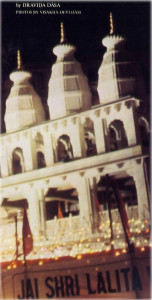 The heart of the Bombay center is the temple of Sri Sri Radha-Rasavihariji. (Radha is the name of Lord Krsna’s eternal consort, and Rasa-vihari is a name for Krsna that means “the enjoyer of the transcendental rasa dance.”) The temple is a majestic structure, replete with twenty-four domes of sculpted marble. The visitor passes through a finely carved red sandstone gate and up a short marble staircase. Then he enters a large courtyard bordered by marble pillars and floral-engraved arches. Graceful trees shade the courtyard’s marble floor.
The heart of the Bombay center is the temple of Sri Sri Radha-Rasavihariji. (Radha is the name of Lord Krsna’s eternal consort, and Rasa-vihari is a name for Krsna that means “the enjoyer of the transcendental rasa dance.”) The temple is a majestic structure, replete with twenty-four domes of sculpted marble. The visitor passes through a finely carved red sandstone gate and up a short marble staircase. Then he enters a large courtyard bordered by marble pillars and floral-engraved arches. Graceful trees shade the courtyard’s marble floor.
In alcoves on either side of the courtyard, fifteen colorful dioramas depict scenes from the ancient Srimad-Bhagavatam, Bhagavad-gita, and Ramayana. (The Ramayana is a classic Vedic scripture recounting the pastimes of Lord Ramacandra, an incarnation of Lord Krsna who appeared ages ago to show the world the behavior of an ideal ruler.) Another diorama shows Srila Prabhupada speaking in New York’s Tompkins Square in the summer of 1966, when he was just starting the International Society for Krishna Consciousness.
To the right of the courtyard, near the temple’s front side, the visitor finds a darsana-mandapa (a roofed area from which to view the Deity) and a vyasasana (a massive marble chair used only by the spiritual master). In front of the three altars are huge teakwood doors with brass castings that depict Krsna’s twenty-four main incarnations, and beyond the doors stand the Deities, on handsomely carved, silver-plated teakwood simhasanas (altar platforms). On the left altar are Lord Nityananda and Sri Caitanya Mahaprabhu, two incarnations of Krsna who appeared in India five hundred years ago to spread the chanting of the Hare Krsna mantra. At Their feet, carved in marble, sit Srila Prabhupada and his spiritual master, Srila Bhaktisiddhanta Sarasvati Thakura. On the center altar are Their Lordships Sri Sri Radha-Rasavihariji—Radha and Krsna – and Their companions Lalita and Visakha. And on the right altar are Sri Sri Sita-Ramacandra, Their servant Hanuman, and Rama’s brother Laksmana.
The Architect
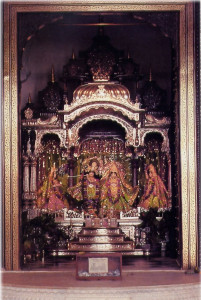
The gifted young architect who designed the temple (and the entire Bombay project) is His Holiness Surabhir-abhipalayantam dasa Gosvami. Now thirty-one, Surabhi Svami graduated from Amsterdam’s Institute for Applied Arts before coming to Bombay and joining the Krsna consciousness movement in March of 1972. It was then that he met Srila Prabhupada, who told him, “Krsna has sent you here for a special purpose. You should build temples for Him all over India. If you do this work for Krsna, that will be the perfection of your life.” Inspired by Srila Prabhupada’s words and his personal presence and further encouragement during the early days at Juhu Beach, Surabhi Svami began designing the Bombay project.
For the next three years the project ran into one problem after another, and Surabhi Svami had to devote much of his time to similar projects in Mayapur, Vrndavana, and Hyderabad. But the experience he gained, especially his two and-a-half-year stay in Vrndavana, proved invaluable. In Vrndavana he had a chance to examine the elegant temple architecture that developed during the Indian Renaissance of the sixteenth, seventeenth, and eighteenth’ centuries, and he later incorporated some of these Renaissance elements into the Radha-Rasavihariji temple.
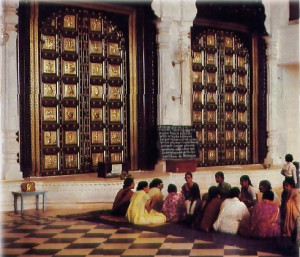
One fascinating aspect of the Bombay project is that it represents a melding of traditional art forms from all over India. “There are two ways of designing,” Surabhi Svami explained. “One way is that you sit down in an office somewhere and come up with a design, and you somehow have people execute it. No matter how difficult it is, you just tell them, ‘I want it like this.’ But, of course, this is very limited—especially for a Westerner like me, who naturally starts out knowing almost nothing about India. There are so many things I would never have thought of if I had just sat at my drawing table. But there’s another way to design, and that is to first see what people can do—and then create the design. I always work the second way.
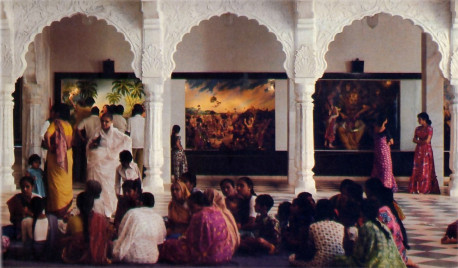
“For the Bombay project I went all over India and saw what people were doing. In India there’s so much work going on already—it simply requires coordination. For the elements of the buildings—the furniture, the simhasanas, the silver work, the marble work, the stone work—I went myself to the places where these things are being done most expertly. Then I either brought the artisans here or had them do the work in their own locale. I simply had to coordinate and then bring everything to Bombay. So now in this project we have a combination of Indian cultural art forms, something which no one has done before in India, anywhere…. For instance, this furniture you see here is all manufactured in a small village named Sankheda, in Gujarat. One whole family has been working on it—the father, the wife, the children, everyone. They do all the carving, the paint work, the lacquering, and so on, and finally they bring everything here and put all the pieces together. That’s how we get the furniture. Then there are the stone carvings. Most of the stone and marble carving is done in Rajasthan. Then there is the brass work from Benares, and the diorama craftsmen from Goa……”

The result of Surabhi Svami’s resourcefulness is a structure that tastefully combines modern structural engineering with traditional Indian craftsmanship, all to glorify Krsna, the Supreme Lord. Unmistakably, the temple reflects Srila Prabhupada’s inspired vision.
The Guesthouse
Adjoining the temple is the guesthouse, a non-profit hotel that offers both shelter and comfort to visitors from India and abroad. Under the expert management of Bali-mardana dasa, the guesthouse offers visitors a peaceful, spiritual environment, just a few steps from the temple, a two-minute walk from the ocean, and a ten-minute ride from Bombay’s international airport (the first stop in India for many tourists).
The guesthouse consists of two seven-story towers finished in finely carved red and white sandstone. (The stone keeps the salty ocean air from penetrating the reinforced concrete and corroding the structural steel within.) Each of the fifty air-conditioned guest rooms has a balcony overlooking the palms of Juhu Beach. One tower has a branch of the Indian Overseas Bank on its ground floor and on its top floor Srila Prabhupada’s former quarters (soon to be a museum in his memory).
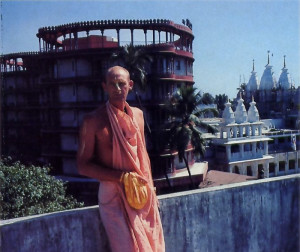
Also included in the guesthouse will be an international library, with editions of Vedic literature in some thirty languages. The library will permit guests from around the world to learn of India’s glorious Vedic culture in their own language, while at the same time they reside in a Vedic community that embodies the very principles they are reading about. In addition to books by Srila Prabhupada, the library will include an extensive collection of books by other important Vedic scholars.
The guesthouse also features the Bombay branch of Govinda’s Restaurant, under the expert guidance of Mr. Michael Lord, who for a decade managed London’s Carlton Club. Govinda’s serves delicious continental and Indian-style vegetarian dishes, all offered to Radha-Rasavihariji before being relished as prasada, “the mercy of the Lord.”
India’s greatest artists are eager to perform in the devotional atmosphere of the Bhaktivedanta Auditorium (right). Famed architect Burjor Mistry spent long hours on the design.
The Book Trust and Research Institute
In separate buildings not far from the guesthouse, the Bombay project also serves as the Indian headquarters for the Bhaktivedanta Book Trust, the world’s largest publisher of books on the philosophy, religion, and culture of India. The director of the Indian branch of the Book Trust is Gopala Krsna dasa, son of a retired Indian naval commander and a disciple of Srila Prabhupada since 1968. In India, the Book Trust publishes India’s great spiritual classics in thirteen Indian languages, as well as in English. It also publishes BACK TO GODHEAD in Hindi., Gujarati, and several other major languages.
Another integral part of the Bombay cultural center is the Bhaktivedanta Institute. The institute promotes advanced study and research into Vedic information on the nature of consciousness and the self. This advanced academic division of the International Society for Krishna Consciousness is led by a team of Indian, European, and American scientists who have recognized the importance of Krsna consciousness. The Institute has published monographs on physics, chemistry, biology, mathematics, and related disciplines, and its speakers travel widely. “Despite great scientific and technological advancements, our civilization has somehow missed the real goal of life,” says Dr. Thoudam D. Singh (Svarupa Damodara dasa), the Institute’s director. “The Bhaktivedanta Institute provides a meaningful answer to this concern by proposing a new scientific paradigm—that life, not matter, is the basis of the world we perceive.”
The Center for the Performing Arts
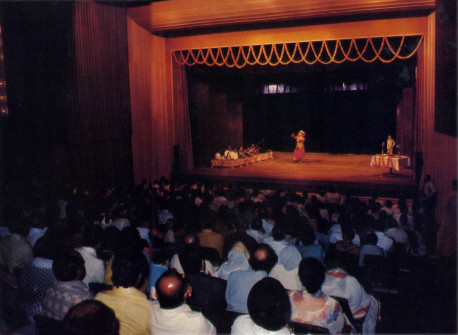
Finally, the Bombay center includes the new Bhaktivedanta Auditorium, where guests may enjoy performances by India’s masters of dance, music, and drama. The theater—not large, but among India’s most sophisticated and versatile—can seat 425. Every seat has headphones that provide simultaneous translation into any of three languages. Other features include the most advanced sound and lighting equipment, 16 and 35mm projectors, stage lifts for special effects, a recording studio, and comfortable green rooms and dressing rooms for the performers.
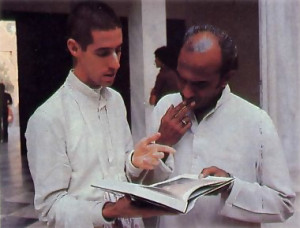
Actually, there was no provision for a theater in the original design for the Bombay center—it seemed too ambitious a venture. But Surabhi Svami, Jagat-purusa dasa, and other devotees felt inspired by Srila Prabhupada’s desire for a full-fledged cultural center. They knew that the center should include a showcase for the best of India’s devotional performers.
Of course, back in April of 1972, when Jagat-purusa arrived in Bombay, what was needed most was a head cook. Since he had always been something of a jack-of-all-trades, Jagat-purusa filled the post for nearly a year and a half and then spent another year managing the day-by-day worship in the temple. But all during this time he never forgot what was really closest, to his heart—Krsna conscious theater. He would regularly visit Surabhi Svami in his little corner of the devotees’ shack, where the first sketches of the Bombay center were taking shape on a makeshift drafting table. On those occasions Jagat-purusa would remind the Svami that some sort of theater should definitely be included. Surabhi Svami was himself very much inclined toward the idea of Krsna conscious theater, and he was further encouraged by yet another theater lover, fellow architect Murti dasa. So Surabhi Svami included space for a theater in his design, and Srila Prabhupada approved it.

But who would actually work up the blueprints? Theater design is a highly specialized field and requires years of training, both in acoustical mathematics and the usual architectural disciplines. There was no way that Surabhi Svami could design it. Yet, fortunately, Burjor Mistry, the consulting architect for the city’s National Center for the Performing Arts and the foremost theater builder in India, stepped forward to help. When he heard that the International Society, for Krishna Consciousness was planning a theater for Krsna conscious performing arts, and that it would be part of a project that would include a modern hotel and classical temple, he felt moved to donate his expert services. His long hours of selfless effort made the Bhaktivedanta Auditorium what it is today.
Now only two questions remained: with the theater built, who would perform and who would attend? When Jagat-purusa and others explored the possibilities of bringing some of India’s top-flight musicians, dancers, and actors to the Bhaktivedanta Auditorium, they got a warm response. Artists like Ravi Shankar, Lata Mangeshkar, M. S. Subalakshmi, Hari Om Sharan, Arvind Parikh, and Vyjayanthimala Bali—all devoted to Krsna and the Vedic culture—were eager to perform in the devotional atmosphere of the Bhaktivedanta Auditorium. Along with many of Bombay’s leading industrialists, film personalities, and society figures, several of these artists also chose to join the congregation of the Radha-Rasavihariji Temple—and, as Jagat-purusa says, “to join the international family of devotees of Lord Krsna”—by becoming life members of ISKCON.
Jagat-purusa further explained, “The life membership program gives everyone the chance to take part in the Krsna consciousness movement in whatever way he can. Some people may want to express their devotion to Krsna by living here and working with the devotees in the temple. Others may choose to express their devotion in other ways—for instance, by offering financial and artistic contributions.” As hundreds and hundreds of Bombay’s leading citizens came forward to become life members, Jagat-purusa saw the opportunity to expand the movement’s cultural influence even further-by creating the Bhaktikala-ksetra.
“The Bhaktikala-ksetra,” Jagat-purusa says, “is an autonomous society dedicated to presenting the teachings of Srimad-Bhagavatam and Bhagavad-gita through the performing arts. It is an independent public trust, with its own constitution and its own executive committee. (Sri M. Deora, the mayor of Bombay, is a member of this committee.) The Bhaktikala-ksetra promotes theater, concerts, films, dance, and so on. And, of course, the Bhaktivedanta Auditorium is the medium through which the activities of the Bhaktikala-ksetra go on, at least for now. Ravi Shankar has offered to give a performance in April, and we have also invited the famous singer M. S. Subalakshmi, our life member in Madras, to give a concert. Vyjayanthimala Bali (India’s foremost exponent of classical bharata-natyam dance), Hari Om Sharan (a popular devotional singer), and Arvind Parikh (a master of the sitar) performed at the grand opening of the theater on January 14.”
So Srila Prabhupada’s inspiration has provided a modern setting where everyone can delight in India’s rich devotional culture. In fact, many people say that the Bhaktivedanta Auditorium heralds a renaissance of devotion in the performing arts.
A Word from the Coordinator
As coordinator for the project, Giriraja dasa has overseen the construction, the life membership program, the financing, and countless other matters. In the following conversation with a BACK TO GODHEAD staff reporter, Giriraja talks about some of the early events at Juhu Beach, Srila Prabhupada’s original ideas for the project, and what the future holds.
BTG: Could you tell us how you got involved in the Bombay project?
Giriraja dasa: In March of 1972, Srila Prabhupada asked me to take charge. This was one month after we had gotten possession of this land at Juhu Beach. When the first few devotees came here, we were living in a hut. It was really difficult, but eventually we built an additional floor on top of some apartment buildings that were already on the land, and we moved up there. From the beginning Srila Prabhupada emphasized that this project is for spreading Krsna consciousness. Every time he would come to Bombay, he would ask us how the rooms were being used, and he was very critical if we were not making full use of each room. The point was that every available facility should be used for spreading Krsna consciousness.
BTG: What were some of the highlights of those early days?
Giriraja dasa: Well, as soon as we got possession of the land, which we named “Hare Krsna Land,” Srila Prabhupada had us put up a pandal [a large platform shaded by decorative canvas] and hold a big Hare Krsna festival. We brought the Deities, Radha-Rasavihariji, from our temple in the city, and every night hundreds of people came to hear Srila Prabhupada speak and also to chant Hare Krsna with us and take in a Krsna conscious drama or musical performance. It was then that we started seeing how right Srila Prabhupada had been in making Juhu Beach the site for a temple and cultural center.
BTG: This was all in March of 1972?
Giriraja dasa: Yes, but because of legal difficulties, it wasn’t until October of 1973 that we finally acquired full title to the land and could really begin planning the center.
BTG: Now, this project is amazingly unique—whose idea was it, and what are its main features?
Giriraja dasa: From the very beginning, the idea was completely Srila Prabhupada’s. Although no one else could understand it at the time, Srila Prabhupada knew that this land at Juhu Beach would make for a perfect center for spreading Krsna consciousness: it was far enough from the city to have the peaceful, spiritual atmosphere of the country, but at the same time it was near enough to the city to be convenient for most people.
BTG: So the temple-hotel-theater complex was originally Srila Prabhupada’s idea—to make it easy for people to come and experience Krsna consciousness?
Giriraja dasa: Yes, exactly. Srila Prabhupada has written that it is the duty of the acarya [a spiritual master who teaches by his very life] to engage everyone in serving Lord Krsna. So Srila Prabhupada’s idea was that whatever people like to enjoy—a comfortable building, good food, beautiful art, music, drama, dance—whatever they want they should have in superlative form, with Krsna in the center. In other words, people should be able to experience what the Indian culture really is—glorification of the Lord. And above all, visitors should have the opportunity to chant the Lord’s names and read Srila Prabhupada’s books.
BTG: Have the people of Bombay responded favorably?
Giriraja dasa: Well, Srila Prabhupada was so farsighted that at first the people here couldn’t appreciate his vision. But now that Juhu has developed into the most important section of Bombay, and now that the people have seen the project take shape, they’re very enthusiastic about it. Many of them want to take an active part.
BTG: What does the future hold for the new cultural center? Do you have plans for more construction?
Giriraja dasa: Yes. Srila Prabhupada wanted us to construct one more large building—six stories—that would include a children’s school, a diorama museum, a retirement home, and a book warehouse. Srila Prabhupada felt that many of Bombay’s pious and aristocratic families would want to send their children to our school to cultivate character and self-realization—in other words, Krsna consciousness. Srila Prabhupada also said that we should include a section for older people. He said there are many old people who want to give everything up, surrender to Krsna, pass their last days in a Krsna conscious community, and then go back home, back to Godhead. So we should provide a facility for them.
BTG: Now, when people come to stay here—at either the guesthouse or the retirement home—will there be guidelines for them to follow?
Giriraja dasa: Yes. To preserve the spiritual atmosphere here, Srila Prabhupada said we should begin by requesting every visitor to follow our four regulative principles—no gambling, no intoxication, no illicit sex, and no meat, fish, or eggs.
BTG: And this would keep the atmosphere pure.
Giriraja dasa: Yes. “Purity is the force,” Srila Prabhupada always said. He told us never to concoct some materialistic scheme for becoming successful. He just wanted us to stay Krsna conscious, do our best, and leave the rest to Krsna.
Governor Patwari Hails the New Cultural Center
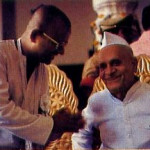
As governor of the southeast Indian state of Tamil Nadu, Sri Prabhudas B. Patwari is understandably appreciative of India’s devotional culture: his state of forty million people is the home of India’s classical bharata-natyam dance, Karnatic music, and some of the most ancient and striking temples in all of the subcontinent. The members of the International Society for Krishna Consciousness felt honored when he gave the following inaugural address for the Radha-Rasavihariji Temple and Vedic Cultural Center.
Sisters and brothers,
I deem it a blessing to be associated with this solemn function. The Krsna consciousness movement is a divine spark, a movement which is meant to give peace and happiness to millions of people all over the world. So I welcome the construction of this temple and the opening of the Bhaktivedanta Center of Vedic Culture in this great cosmopolitan city of Bombay, where people of all races, nationalities, castes and communities, high and low, live in amity. I have no doubt that this Vedic institution will proclaim to the world that here flourishes a great movement, which has become the symbol of eternal religion (sanatana-dharma) .
Krsna appeared like a common cowherd boy, and therefore He is attractive to the common man. Numerous incidents of His life, from childhood onward, reveal how easily He destroyed evil forces and brought success for the good. Now the Krsna consciousness movement has become an international movement, and this is due to the spiritual stature of Sri A.C. Bhaktivedanta Swami Prabhupada, who, with single-minded devotion, dedication, and love for humanity, spread the gospel of Sri Krsna from continent to continent. Through the exalted mission of Svamiji, the life and teachings of Lord Krsna have inspired millions of men and women throughout the world. The departure of this great world-teacher of God consciousness is a severe loss for the whole world, but I am sure he will continue to guide the Krsna consciousness movement through his teachings, as he was guided by Lord Krsna.
What is Krsna consciousness? It is an eternal awareness of Lord Krsna’s greatness and glory as revealed by Him in His avatara [His descent on earth]. Krsna consciousness teaches us that prema-bhakti and nama-sankirtana [loving devotion and the chanting of the Lord’s holy name] constitute the best and easiest pathway to God for all people—a pathway free from perils and pitfalls. Sri Bhaktivedanta Swami Prabhupada added new dimensions to this divine mission.
No one in this world can call himself happy at all times, because trials and tribulations sometimes shake a man’s faith, and life itself becomes a burden. Material prosperity alone cannot give us genuine peace. For that we need spiritual wisdom. Turn the pages of Bhagavad-gita or Srimad-Bhagavatam Maha-purana. Each verse in each chapter contains the quintessence of spiritual wisdom. Those scriptures have through the centuries inspired saints and sages in India. Mahatma Gandhi used to consult the Gita whenever he was in doubt or difficulty. He once said, “The Gita is the universal mother: she turns away nobody; her door is wide open to anyone who knocks. A true votary of the Gita does not know what disappointment is. He ever dwells in perennial joy and peace that passeth understanding, which are reserved only for the humble in spirit. When disappointment stares me in the face, and all alone I see not one ray of light, I go back to the Bhagavad-gita. I find a verse here and a verse there, and I immediately begin to smile in the midst of overwhelming tragedies. My life has been full of external tragedies, and if they have left no visible mark, no indelible scar, on me, I owe it all to the teachings of the Bhagavad-gita.”
In Bhagavad-gita Lord Krsna says:
paritranaya sadhunam
vinasaya ca duskrtam
dharma-samsthapanarthaya
sambhavami yuge yuge
“For the protection of the good, the destruction of the wicked, and the establishment of righteousness, I appear in every age.” The greatest savants of the world have been moved by the Lord’s teachings. Out of great concern for us the Lord, the supreme benefactor of mankind, teaches us through His Gita to do every act as a yajna [sacrifice], without attachment to the fruit of our actions. It is only by a detached outlook in life that we can overcome sorrows and get peace of mind. Attachment takes us away from God, and detachment takes us nearer to Him. By doing everything as a sacrifice to Him, for His sake, we remove false egoism from ourselves and free ourselves from such ideas as “I,” “my,” and “mine.” Lord Krsna says:
sarva-dharman parityajya
mam ekam saranam vraja
aham tvam sarva-papebhyo
moksayisyami ma sucah
“Abandoning all other duties of the body, mind, and intellect, ending the false ego and developing introspection, come to Me alone for shelter. I will liberate thee from all sins; grieve not.” What Lord Krsna teaches Arjuna in the Gita, or what He teaches Uddhava in the Bhagavatam, is the highest and most sublime philosophy, which offers wise guidance to us in day-to-day life. The merciful Lord says that He expects nothing from His devotees except single-minded devotion. The devotee can offer Him even a leaf, a flower, or a drop of water, but it is the devotee’s love for Him that matters. The Lord’s love for us has to be matched by our love for Him.
Srimad-Bhagavatam enjoys universal popularity as the bhakti scripture par excellence. It has inspired the writing of extensive devotional literature, not only in Sanskrit but also in many other Indian as well as foreign languages. The Bhagavatam holds out hope even for the chronic sinner—if only he will open his heart to the gentle influence of the love and charm of Lord Krsna. Like the Gita, it presents a program of practical spiritual training through a harmonious combination of jnana, bhakti, and karma, (knowledge, devotion, and action) suited to the temperament and limitations of the aspirant. Let us, on this occasion, make a solemn resolve to strengthen the Krsna consciousness movement by untiringly spreading the teachings of Lord Krsna through many languages, to all people in all the nooks and corners of the world. In this way, by our genuine devotion to Krsna and by our austerities, we may create an international climate of peace and happiness and lay the foundation for a religious order acceptable to all on the basis of universal love and brotherhood. May we chant “Hare Krsna! Jaya Sri Krsna!” to purify our hearts and minds, and may Lord Krsna shower His blessings on humanity and make our humble endeavors a success.


Leave a Reply